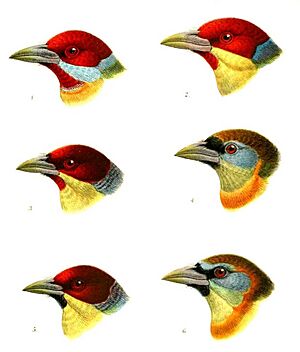New World barbet facts for kids
Quick facts for kids New World barbets |
|
|---|---|
 |
|
| A female red-headed barbet (Eubucco bourcierii) in Peru |
|
| Scientific classification |
|
| Kingdom: | Animalia |
| Phylum: | Chordata |
| Class: | Aves |
| Order: | Piciformes |
| Suborder: | Pici |
| Infraorder: | Ramphastides |
| Family: | Capitonidae Bonaparte, 1838 |
| Genera | |
|
|
The New World barbets are a group of 15 colorful birds that live in the warm, wet forests of Central and South America. Their scientific family name is Capitonidae. These birds are related to toucans and are part of a larger group of birds called Piciformes.
New World barbets are plump birds with short necks and big heads. They get their name from the stiff bristles that grow around their strong beaks. Most of these birds are very brightly colored and live in tropical forests. They spend most of their time in trees, where they also build their nests.
Contents
What are New World Barbets Like?
New World barbets are mostly tree-dwelling birds. This means they spend almost all their time in trees. They dig holes in trees to make their nests, and the male and female birds work together to do this. Inside these tree holes, they lay two to four eggs.
What Do New World Barbets Eat?
These birds love to eat fruit, which is a big part of their diet. They also snack on insects. Barbets are very good at changing what they eat depending on what food is available. They might visit as many as 60 different types of fruit trees and bushes! They can even eat fruits from farms and gardens.
When a barbet eats fruit, it swallows the whole thing. Later, it spits out the hard parts, like seeds. This helps spread seeds around the forest, which is important for new plants to grow. Besides fruit, they also eat insects like ants, beetles, and moths. Sometimes, they even eat scorpions, centipedes, or small animals like frogs!
Do New World Barbets Migrate?
No, these birds do not migrate. They stay in the same area all year round.
Where Do New World Barbets Live?
Most New World barbets live in lowland forests, which are forests found in lower, flatter areas. However, some species can also be found in mountain forests or cooler, temperate forests. They usually need forests that have dead wood, because that's where they dig their nests.
How Are New World Barbets Related to Other Birds?
Scientists have found fossils of New World barbets that are millions of years old, from a time called the Miocene in Florida.
New World barbets are very closely related to toucans. Both of these bird families are also related to honeyguides and woodpeckers. All these birds belong to the same large group called the Piciformes.
In the past, all barbets (from different parts of the world) were thought to be one big family. But now, scientists know that only the barbets from the Americas are in the Capitonidae family. The barbets from Africa (Lybiidae) and Asia (Megalaimidae), as well as two types of toucan-barbets from the Americas (Semnornithidae), are now considered separate families. This helps us understand how these different bird groups evolved.

1. & 2. Eubucco versicolor, males
3. & 5. Eubucco richardsoni, males
4. & 6. Eubucco bourcierii, females
– by Keulemans, 1891
New World Barbets and Humans
New World barbets don't usually have a direct impact on people. However, human activities can affect them. When forests are cut down (deforestation), it can be bad for barbet species that need old, untouched forests to live. On the other hand, some barbet species might do better in areas where the forest has been disturbed or opened up.
Sadly, some New World barbet species are in danger. The IUCN lists three species as threatened:
- The white-mantled barbet from Colombia is listed as endangered. This means it's at high risk of disappearing forever.
- The five-coloured barbet is listed as vulnerable. This means it's likely to become endangered if things don't change.
- The scarlet-banded barbet from Peru is also considered vulnerable. This bird was only recently discovered! It has a small population (less than 1000 birds), but its remote home is not immediately threatened.
The main reasons these birds are in danger are deforestation (forests being cut down for wood, farms, or mining) and their small living areas.

